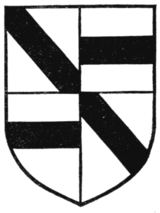nothing; and the rights, such as they are, to the arms of the mother as a quartering remain, and must remain, dormant unless and until arms are established for their father's line, inasmuch as they can only inherit armorially from their mother through their father. In England it is always optional for a man to have arms assigned to him to fill in any blanks which would otherwise mar his scheme of quarterings.
Let us now see how various coats of arms are marshalled as quarterings into one achievement.
 Fig. 759. |
 Fig. 760. |
 Fig. 761. |
The original theory of quartering upon which all rules are based is that after a marriage with an heiress, necessitating for the children the combination of the two coats, the shield is divided into four quarters. These four are numbered from the top left-hand (the dexter) corner (No. 1) across towards the sinister (No. 2) side of the shield; then the next row is numbered in the same way (Nos. 3 and 4). This rule as to the method of numbering holds good for any number of quarterings.
In allocating the position of the different coats to their places in the scheme of quarterings, the pronominal coat must always be in the first quartering.
In a simple case (the exceptions will presently be referred to) that places the arms of the father in the first and fourth quarters, and the arms of the mother in the second and third; such, of course, being on the assumption that the father possessed only a simple coat without quarterings, and that the mother was in the same position. The children therefore possess a coat of four quarters (Fig. 759). Suppose a son of theirs in his turn marries another heiress, also possessing only a simple coat without quarterings, he bears arms as Fig. 760, and the grandchildren descending from the aforesaid marriage put that last-mentioned coat in the third quarter, and the coat, though still of only four quarters, is: 1 and 4, the pronominal coat; 2, the first heiress; 3, the second (Fig. 761).
If another single quartering is brought in, in a later generation, that takes the place of No. 4. So far it is all plain sailing, but very
